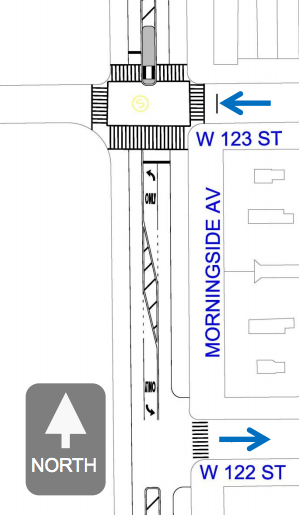
On Wednesday evening, Manhattan Community Boards 9 and 10 jointly hosted a public forum on traffic calming for Morningside Avenue, including a presentation by NYC DOT about its safety proposals. Board members were generally receptive to DOT's plan, which is expected to go back to each board for resolutions of support, while offering their own suggestions -- some reasonable, some not so much. DOT said at the meeting it would like positive votes before moving ahead with the plan.
Wednesday's forum was called after CB 9's full board voted to table the plan and CB 10 declined to take any action on it last month. The plan DOT presented Wednesday was identical to the one it had presented to the boards a month ago [PDF]. "We're here tonight just to continue the dialogue," DOT Borough Commissioner Margaret Forgione said. "We're not in any sort of rush to implement anything and we want to work toward community consensus."
The plan calls for a road diet on Morningside Avenue between 116th and 126th Streets. Currently two lanes in each direction, Morningside would be trimmed to one lane in each direction plus a striped median with left-turn lanes and concrete pedestrian islands. The proposal is similar to road diets DOT has implemented on nearby St. Nicholas Avenue and Gerritsen Avenue in Brooklyn. DOT's Josh Benson pointed out that Gerritsen, which like Morningside Avenue runs alongside a park, saw a 40 percent decrease in injury-causing crashes after the road diet was implemented.
While this type of road diet is known for smoothing out traffic flow, a few board members were skeptical. CB 9 transportation committee co-chair Ted Kovaleff suggested reversible rush-hour lanes instead, an idea that DOT rejected as too difficult to implement. Benson said that right now, Morningside is designed to handle more traffic than it currently accommodates. "It's not really that busy in terms of what other streets in Manhattan have, traffic-wise," Benson said, addressing concerns that drivers would divert to other avenues because of the road diet.
After one board member questioned why the city was interested in changing Morningside's configuration at all, Benson pointed out that safety improvements were requested by the North Star Neighborhood Association. "There's a public safety issue, which is we have New Yorkers that are dying," Benson said. In 2006, there were two fatalities on Morningside Avenue. From 2007 to 2011, there were nine serious injuries; four were pedestrians and one was a cyclist.
During a recent speed survey, DOT found that 58 percent of northbound drivers and 66 percent of southbound drivers were exceeding the 30 mph limit. The street is on the border of the 26th and 28th Precincts. Through August, the latest month for which data is available, the two precincts issued a combined 701 speeding summonses [PDF 1, 2]. Benson said NYPD has issued 260 speeding summonses on these 10 blocks of Morningside so far this year.

The plan also adds a crosswalk and pedestrian signal for people walking along the south side of 125th Street at Hancock Place, just west of Morningside. The intersection, which sees over 500 pedestrians an hour during the evening peak, is confusing because people walking usually have no way of knowing whether drivers, who are often speeding, are going to fork onto Hancock or 125th. In addition to the new signal and crosswalk, striping would direct drivers to split into lanes earlier, giving pedestrians more clarity.
DOT is also proposing a new stop sign and crosswalks at 118th Street, though the stop sign received a mixed reaction among some audience members, who preferred a traffic signal. DOT said at the meeting that it was performing warrant studies for stop lights at all intersections from 116th to 126th, but warned that many of the intersections will not qualify for a traffic signal under its rules.
One area of concern that most meeting attendees agreed on was the intersection of Morningside Avenue and 124th Street, which sees heavy pedestrian traffic from P.S. 125 and Grant Houses. Some residents suggested adding crosswalks, a stop sign, or a traffic signal.
The plan includes an extra-wide 14-foot parking lane similar to the one installed on Lenox Avenue, which DOT said can accommodate cyclists and double-parked cars. One board member said the extra-wide Lenox Avenue parking lane had led to additional double parking there. Other audience members said that the extra space, which is wide enough for a bicycle lane, should be striped for that purpose.
What no one mentioned is that this stretch of Morningside is perfect for a two-way protected bike lane alongside Morningside Park, similar to the two-way bike lane along Prospect Park.
However, CB 10 transportation committee co-chair Maria Garcia did ask if there was anything DOT could do with the board to plan for bike routes. Benson replied that the agency would be happy to set up a series of workshops with the board to identify streets that community members prefer for bike lanes, similar to the process it launched with CB 2 in Queens.
Garcia said that bike route planning workshops in Harlem should involve CBs 9, 10, and 11. "In Harlem a lot of our meetings seem to be very piecemeal in terms of bike routes," she said. "It has to be river to river."
During the comment period, many board members spoke in favor of the traffic-calming plan after requesting tweaks. "We've got to do something and we can't just keep sitting on this," said Brad Taylor, who serves as a CB 9 member and is president of Friends of Morningside Park.
"I commend you guys for taking this one," CB 9 chair Rev. Georgiette Morgan-Thomas said to DOT. "I hope we can make this happen."





